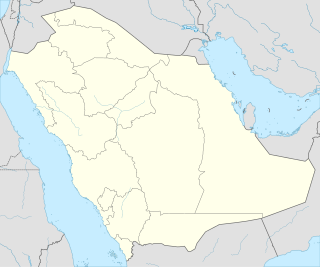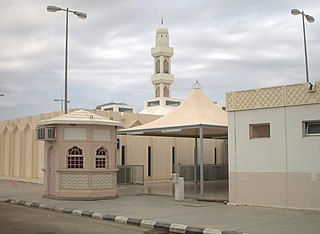
The Hejaz is a region in the west of present-day Saudi Arabia. The region is so called as it separates the land of the Najd in the east from the land of Tihamah in the west. It is also known as the "Western Province". It is bordered on the west by the Red Sea, on the north by Jordan, on the east by the Najd, and on the south by 'Asir Region. Its largest city is Jeddah, but it is probably better known for the Islamic holy cities of Mecca and Medina. As the site of the two holiest sites in Islam, the Hejaz has significance in the Arab and Islamic historical and political landscape.

Salman bin Abdulaziz Al Saud has been King of Saudi Arabia, Prime Minister of Saudi Arabia, and Custodian of the Two Holy Mosques since 23 January 2015.
Badr is a town in Al Madinah Province, Al-Hijaz, Saudi Arabia. It is located at around 23°46′48″N38°47′26″E, and about 130 km (81 mi) from the Islamic holy city of Medina. It was the location of the famous Battle of Badr, between the Quraishi-led Polytheists, and the Muslims under the leadership of Muhammad, in 624 CE.

The Prince Mohammad bin Fahd Stadium is a multi-purpose stadium in Dammam, Saudi Arabia. It was built in 1973 and it was used the name Prince Mohammad bin Fahd. It is used mostly for football matches and is the home of Al-Ettifaq. The stadium's capacity is 36,000 people. It is named after Muhammad bin Fahd, who was the governor of the Eastern Province from 1985 until 2013.

Rafha is a town in the north of Saudi Arabia, close to the border with Iraq. It is located at around 29°38′19″N43°30′5″E. Rafha had a population of 80,544 at the 2010 Census. After Arar, it is the second largest city in the Northern Borders Province. Currently the Ministry of Housing is building over 600 new villas for the local population and others and making significant improvements to the local infrastructure.

Turaif is a town in Northern Borders Province, Saudi Arabia, close to the border with Jordan. Turaif is located at a bend in Highway 85 as it turns west to Jordan. It is located at around 31°40′39″N38°39′11″E. As of 2010, it has a population of 48,929. The city of Turaif is one of the cities that have been established because of the presence of international oil pipeline.

Articles related to Saudi Arabia include:

Al Harrah is a large basaltic volcanic field in northwestern Saudi Arabia near the Jordanian border. It covers an area of 15,200 km2. The volcanic field forms the southern third of the massive Harrat al-Shamah volcanic field, which extends from Syria through Jordan into northern Saudi Arabia. It is in the Tabuk Region of northwest Saudi Arabia. It is one of a series of Quaternary volcanic fields paralleling the Red Sea coast.

Hafar Al-Batin is a Saudi Arabian city in the Eastern Province. It is located 430 km north of Riyadh, 94.2 km from the Kuwait border, and about 74.3 from the Iraq border. The city lies in the dry valley of the Wadi al-Batin, which is part of the longer valley of the river Wadi al-Rummah, which leads inland toward Medina and formerly emptied into the Persian Gulf.
Harrat Kishb is a 5,892 km2 lava field in western Saudi Arabia. Nearby is the Al Wahbah Crater.

The Sultanate of Nejd was the second iteration of the third Saudi state, from 1921 to 1926. It was a monarchy led by the House of Saud. This version of the third Saudi state was created when Abdul Aziz ibn Saud, Emir of Riyadh, declared himself Sultan over Nejd and its dependencies. In December 1925 the Kingdom of Hejaz surrendered to the forces of Abdul Aziz, who was thereafter proclaimed King of Hejaz in January 1926 and merged his dominions into the Kingdom of Hejaz and Sultanate of Nejd.

The Kingdom of Hejaz and Nejd, initially the Kingdom of Hejaz and Sultanate of Nejd, was a dual monarchy ruled by Ibn Saud following the victory of the Saudi Sultanate of Nejd over the Hashemite Kingdom of the Hejaz in 1925. It was the third iteration of the third Saudi state.

Arar is the capital of Northern Borders Province in Saudi Arabia. It has a population of 145,237.
Tabarjal (Arabic:طبرجل) is an important town in northern Saudi Arabia. The nearest big city is Qurayyat. Tabarjal is one of the major modern towns in the region of Al-Jawf, where it has for over forty years organized the settlement project and dug wells.
Saudi Arabians, or Saudis are a nation composed mainly of various regional ethnic groups who are native to the Arabian Peninsula including Hejazis, Najdis, Hassawis, Southern Arabs and others including non-Arabs, who share a common general Saudi culture and a Saudi nationality. Saudis speak one of the accents and dialects of the Peninsular Arabic, including the Hejazi, Najdi, Gulf and Southern Arabic dialects, as a mother tongue. According to the 2010 census, Saudi nationals represented approximately 19,335,377 making up 74.1% of the total population. Saudi Arabia is a state governed by absolute monarchy, with the king as its head of state.

Capital Market Authority Tower is a 385 m (1,263 ft) skyscraper in Riyadh, Saudi Arabia. Construction started in 2010 and was topped-out in 2014. It became the tallest building in Riyadh, surpassing the Kingdom Centre and Burj Rafal.

The Royal Saudi Strategic Missile Forces or RSSMF is the fifth branch of the Saudi Arabian Armed Forces, responsible for commissioning long-range strategic missiles. The RSSMF formerly had its headquarters in an underground command facility in Riyadh– the capital of Saudi Arabia.















